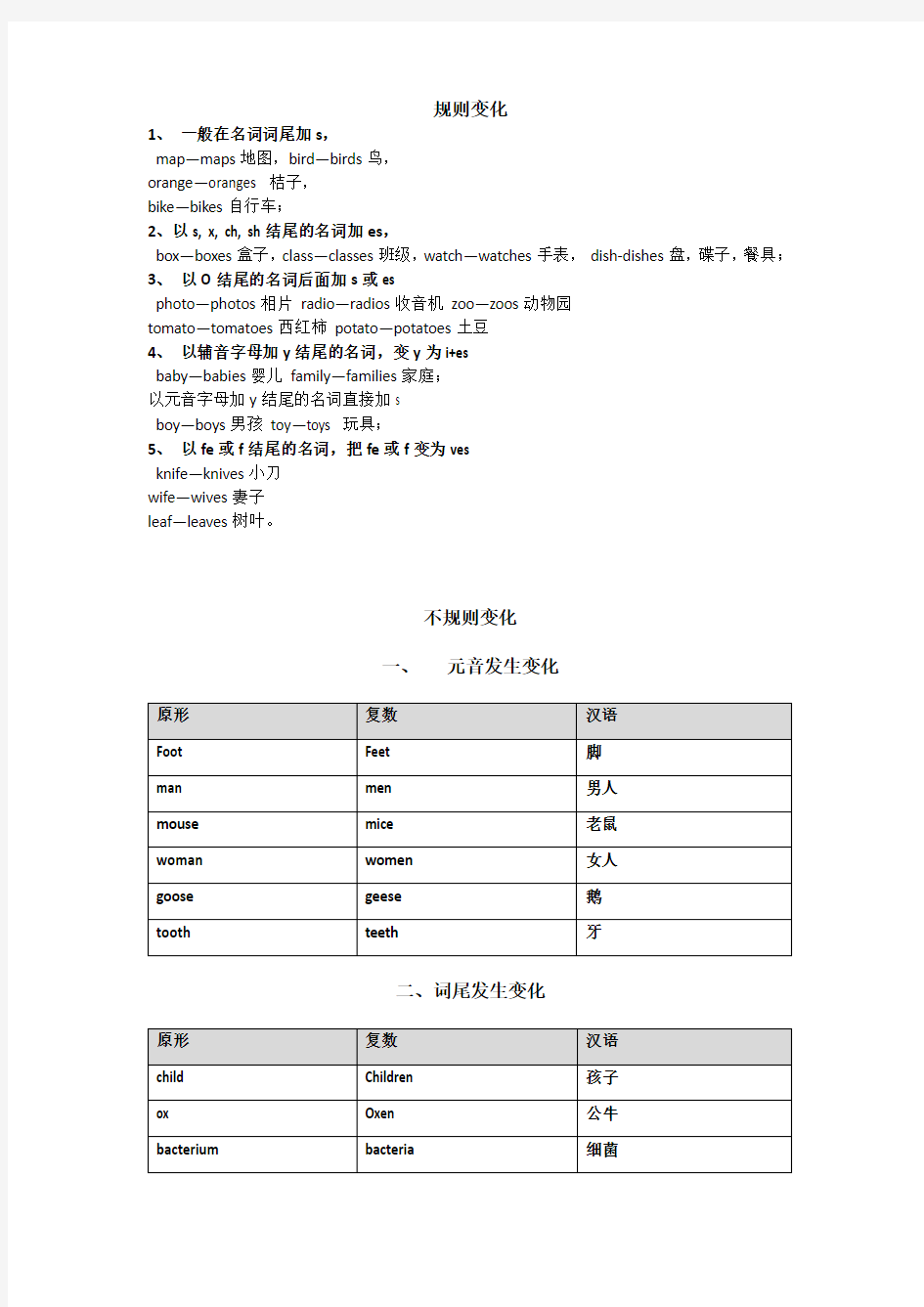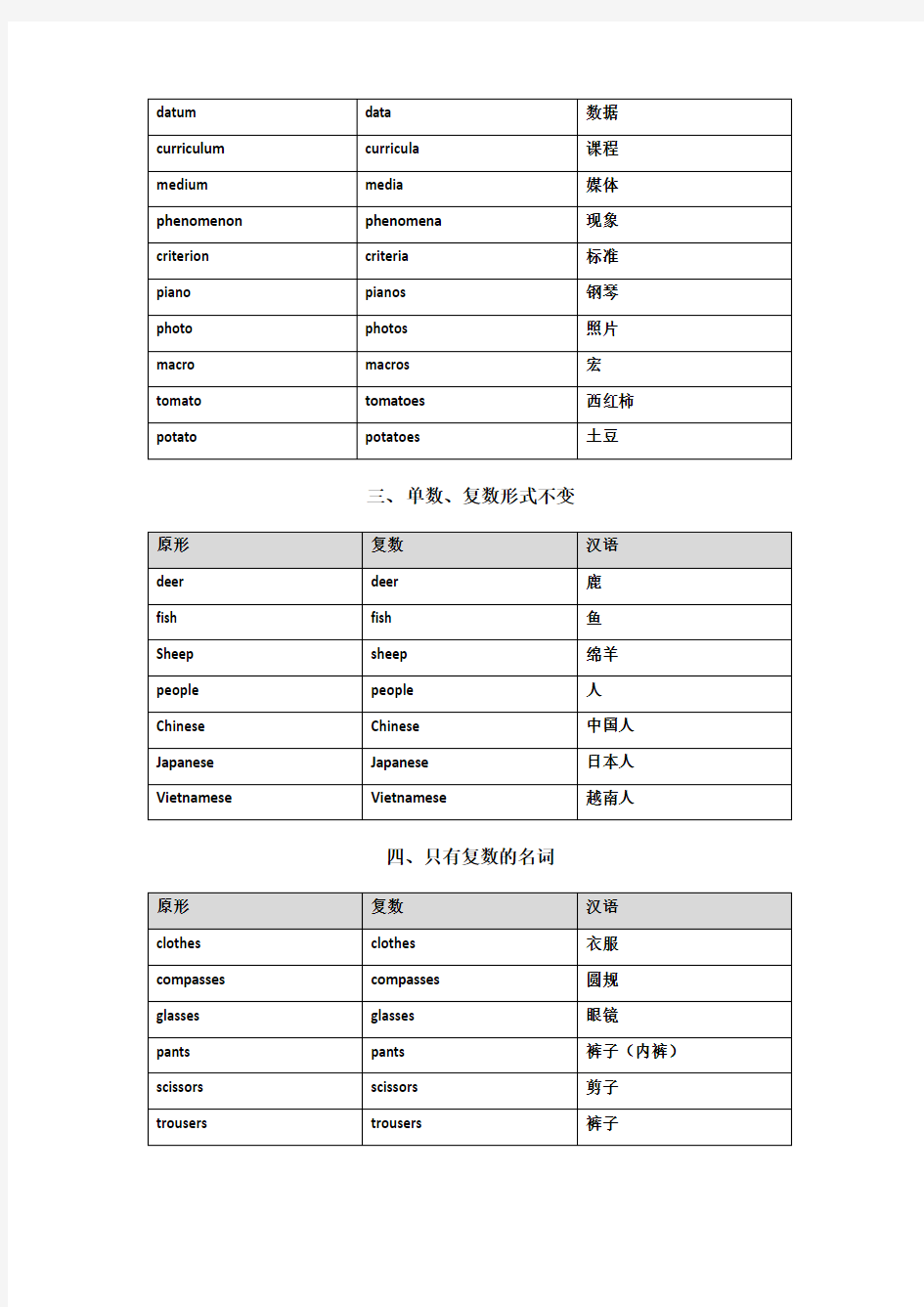名词变复数规则、不规则变化


规则变化
1、一般在名词词尾加s,
map—maps地图,bird—birds鸟,
orange—oranges 桔子,
bike—bikes自行车;
2、以s, x, ch, sh结尾的名词加es,
box—boxes盒子,class—classes班级,watch—watches手表,dish-dishes盘,碟子,餐具;
3、以O结尾的名词后面加s或es
photo—photos相片radio—radios收音机zoo—zoos动物园
tomato—tomatoes西红柿potato—potatoes土豆
4、以辅音字母加y结尾的名词,变y为i+es
baby—babies婴儿family—families家庭;
以元音字母加y结尾的名词直接加s
boy—boys男孩toy—toys 玩具;
5、以fe或f结尾的名词,把fe或f变为ves
knife—knives小刀
wife—wives妻子
leaf—leaves树叶。
不规则变化
一、元音发生变化
二、词尾发生变化
三、单数、复数形式不变
四、只有复数的名词
五、第一个或最后一个词变成复数
六、构成合成名词的两个词都要变为复数
名词变复数变化规则
智博教育名词变复数变化规则 1.一般情况下,直接加-s,如:book-books, bag-bags, cat-cats, bed-beds ,pig-pigs ,pear-pears ,ruler-rulers,bag-bags,tree-trees 2.以s. x. sh. ch结尾,加-es,如:bus-buses, box-boxes,fox-foxes brush-brushes, watch-watches,peach-peache,dress-dresses, dish-dishes. 3.以“辅音字母+y”结尾,变y为i, 再加-es,如:family-families, strawberry-strawberries body-bodies,cherry-cherries,特别强调boy复数boys ,toy复数toys(a,e,I,o,u原音字母加y结尾的单词直接加s.) 4.以“f或fe”结尾,变f或fe为v, 再加-es,如: knife-knives,wolf-wolves,wife-wives 5.不规则名词复数: man-men,woman-women,policeman-policemen, policewoman-policewomen, mouse-mice child-children, this-these, that-those, I-we, he,she,it-they foot-feet,.tooth-teeth ,goose-geese. fish-fish, people-people, Chinese-Chinese, Japanese-Japanese 6.不可数名词不加s或es液体类和肉类; tea,offee,milk,soup,coke,juice,beer,water,rain,snow,beef,chicken,fish, mutton.(fish,people,sheep,Chinese,不变化). _
名词复数不规则变化
名词复数的不规则变化 ①内部元音字母发生变化。如: foot—feet足man—men 男人mouse—mice鼠woman—Women女人policeman—policemen警察tooth—teeth牙齿 ②词尾发生变化。如: ox—oxen 公牛child—children孩子 ③有个别名词单复数形式一样。如: deer—deer鹿fish—fish 鱼sheep—sheep羊 means—means方法works—works工厂 ④表示“某国人”的单、复数变化 Chinese—Chinese中国人Japanese—Japanese日本人Swiss—Swiss瑞士人 -s。如: German—Germans德国人Russian—Russians 俄罗斯人Roman—Romans 罗马人American—Americans美国人Australian—Australians 澳大利亚人Indian—Indians印度人 man为men。如: Frenchman—Frenchmen法国人Englishman—Englishmen英国人
⑤复合名词的复数变化 a son-in-law sons-in-law 女婿 a passer-by passers-by 过路人 a looker –on lookers–on 旁观者 -s。如: a grown-up grown-ups 成年人 a go-between go-betweens 中间人 a boy student boy students 男学生 a girl friend girl friends 女朋友 a man teacher men teachers 男教师 a woman doctor women doctors 女医生或女博士
名词变复数规则
一.名词变复数规则 1.一般名词复数是在名词后面加上“s”,如map→maps,bag→bags等; 2.以s,sh,ch,x等结尾的词加“es”,如bus→buses,watch→watches等; 3.以辅音字母+y结尾的词,变y为i加es,如baby→babies等; 以元音字母+y结尾的名词变复数时,直接加s变复数,如monkey→monkeys,ho liday→holidays, 4.以o 结尾的名词变复数时:(1)没有生命的名词加s:如photo→ph otos ,piano→pianos, radio→radios,(2)有生命的名词加es:如potato→potatoes;tomato→tomatoes;hero—heroes 5.以f或fe结尾的名词变复数时:变f或fe为v,再加es 如:leaf ; thief; wolf ; wife ; knife ; life 6.不规则的名词变复数, 如:man ; policeman; woman ; policewoman; child ; foot ; tooth ; mouse ; sheep ; deer ; fish ; Chinese; Japanese 二.动词变三人称单数 1.一般情况加–s 如:make ; stop ; help 2.以s,sh,ch,x等结尾的词加–es 如:dress; pass ; wash ; teach ; watch ; teach ; fix 3.以辅音字母+y 变y 为i结尾的词再加es 如:study ; fly ; try ; carry 以元音字母加y结尾的词,直接加-ed 如:play ;stay ; enjoy ; 4.以“o”结尾的动词,加“es”,如:go ; do 三.动词变现在分词(即-ing形式) 1. 一般情况,加-ing 如:go ; ask ; look ; watch 2. 以不发音的e结尾的动词,去e,再加-ing 如:write ; make ; take; practice ; 3. 以重读闭音节结尾的动词,末尾只有一个辅音字母,双写这个辅音字母,再加-ing 如:get ; sit ; run ; put ; begin ; swim ; stop ; plan ; shop 四.动词变过去式 1. 一般情况,加-ed 如:look ; play ; start ; listen 2. 以e结尾的动词,加-d 如:hope ; use ; live ; decide 3. 以重读闭音节结尾的动词,末尾只有一个辅音字母,双写这个辅音字母,再加-ed 如:stop ; plan; shop 4. 以辅音字母加y结尾的动词,变y为i,再加-ed 如:study ; carry ; worry ; try ;
可数名词不规则变化
可数名词复数的不规则变化: 1)child---children foot---feet tooth---teeth mouse---mice man---men woman---women 注意:与man 和woman构成的合成词,其复数形式也是-men 和-women。 注意:man, woman, gentleman等作定语时,其单复数以所修饰的名词的单复数而定。 如:men workers women teachers gentlemen officials 2)单复同形如: -deer,sheep,fish, -钱:li,jin,yuan,two li,three mu,four jin 但除人民币元、角、分外,美元、英镑、法郎等都有复数形式。如: a dollar, two dollars; a meter, two meters -Chinese,Japanese 人 3)集体名词,以单数形式出现,但实为复数。 如:staff people police cattle 等本身就是复数,不能说a staff a people,a police,a cattle, 但可以说a person,a policeman,a head of cattle, the English,the British,the French,the Chinese,the Japanese,the Swiss 等名词,表示国民总称时,作复数用。 如:The Chinese are industries and brave.中国人民是勤劳勇敢的。 4)以s 结尾,仍为单数的名词,如: a. maths,politics,physics等学科名词,为不可数名词,是单数。 b. news 是不可数名词。 c. the United States,the United Nations 应视为单数。 The United Nations was organized in 1945. 联合国是1945年组建起来的。 d. 以复数形式出现的书名,剧名,报纸,杂志名,也可视为单数。 "The Arabian Nights" is a very interesting story-book. <<一千零一夜>>是一本非常有趣的故事书。 5) 表示由两部分构成的东西,如:glasses (眼镜)trousers,clothes; 若表达具体数目,要借助数量词pair(对,双);suit(套); a pair of glasses; two pairs of trousers
最新名词单数变复数变化规则
名词单数变复数变化规则: 一.可数名词 1.一般名词复数是在名词后面加上“s”,如map→maps,bag→bags,book-books 等; 2.以s,x,sh,ch结尾的词加“es”,如bus→buses,watch→watches, box-boxes 等; 3.以f或fe结尾的名词变复数时,去掉f,fe 加ves的名词有:half→halves knife →knives leaf→leaves wolf→wolves wife→wives life→lives thief→thieves 4.以o 结尾的名词变复数时: a)加s的名词有(无生命):photo→photos ,piano→pianos,radio→radios b)加es的名词有(有生命):potato→potatoes tomato→tomatoes 5.以辅音字母+y结尾的词,变y为i加es,如baby→babies, family-families, study-studies等; 以元音字母+y结尾的名词变复数时,直接加s变复数,如monkey→monkeys,holiday→holidays,storey→storeys(楼层); 6. oo变ee的单词:foot-feet, goose-geese, tooth-teeth; 7. a变e的单词:man-men, woman-women, policeman-policemen; 8. 复数与原形一致的单词:fish-fish, sheep-sheep, deer-deer, Chinese-Chinese, Japanese-Japanese; 注:1.fish指“鱼肉”时,是不可数名词;2.fish指“鱼的多少”时,是可数名词,但单数和复数同行;There are many fish in the river。3.fish强调鱼的“种类“时,复数是“fishes”。There are many kinds of fishes in the river。 9. 有些名词以-s结尾,但表达的是单数意义,例如:news,maths,politics,physics,the United States等。 10. 常以复数形式出现的名词,例如:glasses,trousers,shoes,gloves,socks 等,要表达他们的量时常用pair,例如:a pair of glasses/shoes; 复数只需量词变复数,例如:two pairs of shoes 11. 名词作定语时,不用复数形式,如:a shoe shop。如果要表示复数,则去掉不定冠词,把名词词组中的最后一个名词变成复数形式,如:an apple tree---apple trees
(完整版)特殊名词变复数
名词的词形变化 1.不规则复数形式 1)来自古英语的复数形式,如: child---children foot---feet tooth---teeth goose---geese man---men woman---women mouse---mice louse---lice ox---oxen penny---pence analysis---analyses appendix---appendices parenthesis---parentheses basis---bases stimulus---stimuli ellipsis---ellipses axis---axes hypothesis---hypotheses oasis---oases crisis----crises criterion---criteria phenomenon---phenomena datum---data medium---media bacterium---bacteria nucleus---nuclei fungus---fungi alumnus---alumni focus---foci radius---radii terminus---termini larva---larvae alga---algae formula---formulae data---datas lens---lenses。 2)词尾读音为[f]并以-f或0-fe结尾的名词复数形式有以下几种情况: a)规则形式: belief---beliefs chief----chiefs cliff----cliffs grief----griefs b)不规则形式,即把-f或-fe变成-v,再加-es,读音为[vz]: calf---calves half---halves leaf----leaves life----lives loaf---loaves self---shelves thief---thieves wife---wives wolf---wolves c)既可是规则形式又可是不规则形式: dwarf---dwarfs/dwarves hoof---hoofs/hoves scarf---scarfs/scarves wharf---wharfs/wharves 3)词干以-o结尾的名次有三种情况: a)附属形式为-s:这类词包括缩略词kilos, photos;表示国籍或民族的词Filipinos, Eskimos以及radios ,solos, sopranos, studios b)复数形式为-es,如:heroes, potatoes, tomatoes, Negroes。 c)复数有规则的和不规则的两种形式,如: cargo---cargos/cargoes mosquito---mosquitos/mosquitoes volcano---volacbos/volcanoes 2.单复数同形的名词 1)某些动物名词,如:deer, grouse, salmon, trout, carp, bison, sheep等 2)以-ese或-ss结尾的表示民族或国籍的名词,如:Chinses, Japanese, Portuguese, Swiss, Vietnamese等
不规则名词复数形式
不规则名词复数形式 不规则名词复数形式 1.以,f或,fe结尾的名词变复数 (1)加,s,如: belief-beliefs roof-roofs gulf-gulfs (2)去f,fe加,ves,如: half-halves knife-knives leaf-leaves life-lives wolf-wolves thief-thieves self-selves wife-wives shelf-shelves 歌诀记忆:树叶(leaf)半数(half)自己(self)黄;妻子(wife)拿刀(knife)去割粮;架(shelf)后窜出一匹狼(wolf);就像小偷(thief)逃命(life)亡。这9个名词变复数时,都要改,f(e)为v,再加,es,其他的以,f(e)结尾的名词则直接加,s变复数。 2.以,o结尾的名词,变复数 (1)加s,如:photo-photos piano-pianos radio-radios zoo-zoos kilo-kilos (2)加es,如:potato-potatoes tomato-tomatoes Negro-Negroes hero-heroes 歌诀记忆:黑人(Negro)和英雄(hero)爱吃西红柿(tomato)和马铃薯(potato)。除了这四个以,o结尾的名词加,es外,其余的以,o结尾的名词加,s。 3.表示“国家”的名词变复数 Chinese-Chinese Japanese-Japanese Englishman-Englishmen Frenchman-Frenchmen German-Germans Russian-Russians Indian-Indians Canadian-Canadians American-Americans
名词复数变化规则大全
英语名词复数的规则变化 英语中名词可分为可数名词和不可数名词。可数名词在应用时有单数和复数形式。表示一个用单数,表示两个或两个以上用复数。复数名词的构成分为规则变化和不规则变化。 一、规则变化: 1、一般在名词词尾加s, ①map—maps地图,bird—birds鸟, orange—oranges 桔子, bike—bikes自行车; 2、以s, x, ch, sh结尾的名词加es, ①box—boxes盒子,class—classes班级,watch—watches手表,dish-dishes盘,碟子,餐具; 3、以O结尾的名词后面加s或es ①photo—photos相片radio—radios收音机zoo—zoos动物园tomato—tomatoes西红柿potato—potatoes土豆 4、以辅音字母加y结尾的名词,变y为i+es ①baby—babies婴儿family—families家庭; 以元音字母加y结尾的名词直接加s ①boy—boys男孩toy—toys 玩具; 5、以fe或f结尾的名词,把fe或f变为ves ①knife—knives小刀 wife—wives妻子 leaf—leaves树叶。 二、名词复数的不规则变化 1、child---children foot---feet tooth---teeth mouse---mice man---men woman---women 注意:与man 和woman构成的合成词,其复数形式也是-men 和-women。 如:an Englishman,two Englishmen. 但German不是合成词,故复数形式为Germans;Bowman是姓,其复数是the Bowmans。2、单复同形如:
名词变复数的不规则变化
名词变复数的不规则变化 1.child---children foot---feet tooth---teeth mouse---mice man---men woman---women 注意:由一个词加 man 或 woman构成的合成词,其复数形式也是 -men 和-women,如an Englishman,two Englishmen。但German不是合成词,故复数形式为Germans;Bowman是姓,其复数是the Bowmans。 2.单复同形,如deer,sheep,fish,Chinese,Japanese ,li,jin,yuan,two li,three mu,four jin等。但除人民币的元、角、分外,美元、英镑、法郎等都有复数形式。如:a dollar, two dollars; a meter, two meters。 3.集体名词,以单数形式出现,但实为复数。例如: people police cattle 等本身就是复数,不能说 a people,a police,a cattle,但可以说a person,a policeman,a head of cattle. 4.以s结尾,仍为单数的名词,如: ①. maths,politics,physics等学科名词,一般是不可数名词,为单数。
②. news 为不可数名词。 ③. the United States,the United Nations 应视为单数。 The United Nations was organized in 1945. 联合国是1945年组建起来的。 ④. 以复数形式出现的书名,剧名,报纸,杂志名,也可视为单数。例如: "The Arabian Nights" is a very interesting story-book. 《一千零一夜》是一本非常有趣的故事书。 5.表示由两部分构成的东西,如:glasses (眼镜)trousers, clothes等,若表达具体数目,要借助数量词pair(对,双); suit(套); a pair of glasses; two pairs of trousers等。 6.另外还有一些名词,其复数形式有时可表示特别意思,如:goods货物,waters水域,fishes(各种)鱼。 7. 有些表示生物的名词,其复数形式与单数相同。如:fish-fish, sheep-sheep, deer-deer。这类名词还有aircraft, means等
名词复数形式的变化规则
名词复数形式的变化规则; 1.大多数情况下,直接加s 2.以 s x sh ch结尾的名词变复数,加es 3. 以 f fe 结尾的名词变复数,把 f fe 变为ves. 4. 以辅音字母加y 结尾的名词变复数,把y 变 i 再加es. 例如,family 以辅音字母l 加y 结尾,所以复数形式为families, boy也是以y 结尾的,但它是以元音字母o加y结尾的,所以复数形式为boys 5. 有些以字母o 结尾的名词变复数加es,例tomato es,potato es 6.还有一些不规则变化的,需要同学们分清记牢。如sheep——sheep,child------ children 二、练习题。 <一>、写出下列名词的复数形式 1、orange 2、class 3、 text 4、monkey 5、piano 6、 child 7、shelf 8、 bed 9、country 10、family 11、toy 12、 foot 13、Japanese 14、radio 15、 photo 16、army 17、tomato 18、 fox 19、woman 20、knife 22、 sheep <二>、选择填空 1、There on the wall .They are very beautiful. A. are photoes B. are photos C. is a photo D. is photos 2. This kind of car made in Shanghai. A. is B .are C .were D .has 3. There are four and two in the group. A. Japanese, Germen B Japaneses, Germen C. Japanese,German C.Japanese, Germans 4. That’a art book. A. an B. a C. the D are 5. The boys have got already. A. two bread B. two breads C. two pieces of bread D. two piece of bread 6. The old man wants . A. six boxes of apples B. six boxes of apple C. six box of apples D. six boxs of apples 7. There some in the river.
英语名词的复数变化规则
英语可数名词的复数变化规则: 1、一般情况下加S 例如: book——books ruler——rulers hen——hens 2、以s、x、ch、sh 结尾,加es 例如: } bus——buses box——boxes watch——watches dish——dishes 3、以元音字母+y结尾,加s (元音字母:a o e i u) 例如: monkey——monkeys holiday——holidays , toy——toys 4、以辅音字母+y结尾,去掉y,加ies 例如: story——stories baby——babies ①直接加s
5、以f、fe结尾有的②去掉f或fe,加ves ③既可以直接加s,又可以去掉f、fe加ves ( 以f、fe结尾,直接加s 顺口溜:海湾农奴信酋长,悬崖证据在房顶。 gulf——gulfs[ɡ?lf]海湾 serf——serfs[s??f]农奴、奴隶 belief——beliefs[b?'li?f]信 chief——chiefs [t?i?f]酋长 cliff——cliffs[kl?f] 悬崖 proof——proofs[pru?f]证据 】 roof——roofs[ru?f]房顶 以f、fe结尾,加es 顺口溜:妻子持刀去宰狼, 小偷吓得发了慌, 躲在架后保己命, 半片树叶遮目光。 wife——wives[wa?f] 妻子 — knife——knives[na?f] 小刀 wolf——wolves[w?lf] 狼 thief——thieves[θi?f]小偷
shelf——shelves[?elf] 架子 self——selves[self] 自己 life——lives[la?f] 生命 half——halves[hɑ?f]一半 leaf——leaves[li?f]树叶 ; 注:关于self的复合词,也是去掉f加ves 例如: myself——ourselves yourself——yourselves himself(herself)——themselves 以f、fe结尾,既可以直接加s,又可以去掉f、fe加ves 顺口溜:码头侏儒围围巾,手绢复数变二心。 例如: 、 Wharf [w??f]码头 Dwarf [dw??f]侏儒 Scarf [skɑ?f]围巾 Handkerchief ['h??k?t??f] 手绢 6、以O结尾的一般有两种情况,但是也有特殊情况。 一般无生命的加s 例如: auto——autos['??t??] 汽车 ·
名词单数变复数规则及练习
小学英语语法:名词 1.名词分为专有名词和普通名词。 如:GuangZhou,Mike,UNESCO等。 专有名词一般情况下第一个字母要大写,前面不加定冠词the。 如:police,eggs,rice等。 表示某一类人或某一类东西中的个体。如:monkey,panda,ruler,boy等。 表示一群人或一些事物的总称。如:family,police,class,people等。 Water,air,milk等。 hope,love,spirit。 1.定义:一般来说,个体名词和集体名词多为 物质名词和抽象名词多为 2.可数名词的数: 表示“一个”时用单数,a bird,a teacher,an apple,表示“多个”时用复数。two birds,five teachers,eight apples.
3.可数名词复数的变化规则. A、一般情况下,在单数名词的后面加-s构成。如:game-games,boy-boys等。 B、以s、x、sh、ch结尾的单数名词变复数,在词尾加-es构成。如:box-boxes,bus-buses,peach-peaches,dish-dishes。 C、以o结尾,表示有生命的事物的单数名词变复数加-es;表示没有生命的事物的单数名词变复数加-s。如:potato-potatoes,tomato-tomatoes,photo-photos,piano-pianos等。 D、以辅音字母加y结尾的单数名词变复数,将y改成i后再加-es。如:factory-factories,story-stories,family-families。 E、以f或fe结尾的单数名词变复数,将f或fe改成v,然后再加-es。如:leaf-leaves,life-lives,knife-knives等。 F、名词单数变复数,除了有规则可循的变化之外,还有一部分的变化是不规则的,我们将这部分名词的变化叫做不规则变化。这些词有:goose-geese,foot-feet,tooth-teech,man-men,woman-women,mouse-mice,sheep-sheep,deer-deer,fish-fish,child-children,ox-oxen 4.不可数名词量的表示 需给这些词计量,我们于是采用这种方法: 如:a cup of tea,a box of milk,a piece of paper等。 如果为了表示多个的概念,我们就将表示这些东西的单位变成复数即
英语动词单三变化规则及名词单数变复数口诀
动词的第三人称单数现在式变化规则: 1)一般由动词原形加-s get-gets play-plays 2)以e结尾的动词,加-s like-likes make-makes 3)以o结尾的动词加-es go-goes do-does 以s, x, ch, sh等字母结尾的动词,后面加-es kiss-kisses fix-fixes teach-teaches fish-fishes 4)以辅音字母加y结尾的动词,先将y变i, 再加-es fly-flies study-studies 5) have –has 一般现在时 主语+动词原型V I have a friend. You have a friend. We have a friend. They have a friend. 主语(第三人称单数)+动词V(三单) She / He / It has a friend. Tom / My mother has a friend.
名词单数变复数口诀 (一) 规则变化 名词单数变复数,直接加-s 占多数; s, x, z, ch, sh 来结尾,直接加上-es; 词尾是 f 或fe,加-s 之前先变ve; 辅母+ y 在词尾,把y 变i 再加-es; 词尾字母若是o,常用三个已足够, 要加-es 请记好,hero, tomato, potato。 (二) 不规则变化 男人女人 a 变e,鹅足牙oo 变ee; 老鼠虱婆也好记,ous 变ic; 孩子加上ren,鱼鹿绵羊不用变。 This---these(这些) that -- those(那些) 【解说】 1. 英语名词有单数和复数的区别,单数表示“一”,复数表示“多于一。”名词由单数变复数,多数是规则的变,直接加-s,例如:book →books, girl →girls。但以-s, -z, -x, -ch, -sh 结尾的名词,变成复数时加-es, 例如:bus →buses, buzz →buzzes, box →boxes, watch →watch es, brush →brushes 2. -f(e) 结尾的名词单数变复数歌诀:①树叶半数自已黄,妻子拿刀去割粮,架后窜出一只狼,就像强盗逃命忙。②妻子持刀去宰狼,小偷吓得发了慌,躲在架后保己命,半片树叶遮目光。例如:leaf (树叶,叶子),half (一半),self (自已),wife (妻子),knife (刀子),shelf (架子),wolf (狼), thief (窃贼,强盗) 和life (生命),这些名词变成复数时,都要改-f (e) 为v,再加-es。 3. -f 结尾的名词直接加-s 变复数歌诀:海湾边、屋顶上,首领奴仆两相望;谁说他们无信仰,证据写在手帕上。例如:
名词单复数变化规则
名词单复数变化规则 一、可数名词都有单数和复数之分。 A: 规则的可数名词的复数变化规则: 1.一般情况加s :book-- books mouth---mouths house---houses girl---girls 2.以s 、sh 、ch 、x结尾的加es :class--- classes box----boxes ma tch----matches 3.辅音音素+ y结尾的变y为i加es:city---cities country----countries p arty----parties factory----factories 4.以o 结尾的词+es的只有以下词:heroes Negroes tomatoes potatoes z eroes/zeros 以o 结尾并且词尾有两个元音字母+s radios, zoos, bamboos ,(pianos ,kilos photos) 5.以f,fe 结尾的变f或fe为v +es : thief thieves wife wives life lives knife knives wolf wolves half halves leaf leaves shelf shelves B: 名词词尾的读音规则: 1.在[ p] [t] [k] [f]等清辅音后读[s] cups,hats,cakes,roofs 2. 在[s] [z] [∫] [t∫]等音后读[iz] glasses, faces, roses. 3.在其他情况下读作[z] beds days cities knives. 4.以th结尾的词原来读[ ] 加词尾后多数读[ ] 如:mouth—mouths path—paths ; 但是也有不变化的,如:month—months, ninth—ninths, youth—youths. C: 不规则的可数名词的变化规则: 1.man—men, woman—women, tooth—teeth, foot—feet, goose—geese child—c hildren, mouse—mice, 2.单复数相同: sheep, deer, Chinese, Japanese Swiss. 3.以man, woman 修饰名词构成合成词时,两个词都变化. man servant—men servants. (boy/girl students) woman doctor—women doctors.
英语动词单三变化规则及名词单数变复数口诀
英语动词第三人称单数变化规则及 名词单数变复数口诀 一、动词的第三人称单数现在式变化规则: 1)一般由动词原形加-s get-gets play-plays 2)以e结尾的动词,加-s like-likes make-makes 3)以o结尾的动词加-es go-goes do-does 4)以s, x, ch, sh等字母结尾的动词,后面加-es kiss-kisses fix-fixes teach-teaches fish-fishes 5)以辅音字母加y结尾的动词,先将y变i, 再加-es fly-flies study-studies 6) have –has 1、一般现在时 ①主语+动词原型V I have a friend. You have a friend. We have a friend. They have a friend. ②主语(第三人称单数)+动词V(三单) She / He / It has a friend. Tom / My mother has a friend.
2.不规则动词过去式与过去分词分类记忆表 (一)、AAA. (原形,过去式和过去分词一致) 1. 花费 cost cost cost 2. 割 cut cut cut 3. 伤害 hurt hurt hurt 4. 让 let let let 5. 放 put put put 6. 朗读 read read read 7. 设置 set set set 8.打击,碰撞 hit hit hit 9.关上门窗 shut shut shut 10.让 let let let (二)、ABB(过去式和过去分词一致) 1) 过去式、过去分词含有-ought 1. 带来 bring brought brought 2. 买 buy bought bought 3. 打架 fight fought fought 4. 想 think thought thought 5. 寻找、探究 seek sought sought 2) 过去式、过去分词含有-aught 5. 抓住 catch caught caught 6. 教 teach taught taught t替换原形-d 3) 过去式、过去分词- 7. 建筑 build built built 8. 借出 lend lent lent 9. 花费 spend spent spent 10.派遣 send sent sent 4) 过去式、过去分词 在原形词尾加t或d 11. 学会 learn learnt/ed learnt/ed 12. 意思 mean meant meant 13. 燃烧 burn burnt/ed burnted 13. 做梦 dream dreamt/ed dreamt/ed 13. 处理 deal dealt dealt 14. 听 hear heard heard 5) 过去式、过去分词改为-ept 15. 保持 keep kept kept 16. 睡觉 sleep slept slept 17. 扫 sweep swept swept 6) 过去式、过去分词改为-elt
可数名词变复数规则总结
可数名词变复数规则总结 英语名词单数变复数主要有以下规则: 一、绝大多数的可数名词的复数形式,是在该词末尾加上后辍-S。读音变化:结尾是清辅音读[s],结尾是浊辅音或兀音读[z]。 例: friend —friends; cat —cats; style —styles; sport —sports; piece —pieces 二、凡是以s、z、x、ch、sh结尾的词,在该词末尾加上后辍-es构成复数。读音变化:统一加读[iz]。 例: bu厂buses; quiz —quizzes; fox —foxes; match —matches; flash —flashes box —boxes; watch —watches; actress —actresses; class —c(s长途车oach —coaches; dress —dresses; sandwich —sandwiches; toothbrush —toothbrushes; waitress (女侍者)—waitresses 三、以辅音字母+y结尾的名词,将y改变为i,再加-es。 读音变化:加读[z]。 例: candy—candies; daisy (雏菊)—daisies; fairy —fairies; lady —ladies; story —stories strawberry —strawberries; baby —babies; puppy —puppies; library —libraries; dictionary —dictionaries; cherry —cherries; activity —activities 四、以-o结尾的名词,如果不是外来词或缩写,就加-es,否则加-s构成复数。(有生命的加es 无生命的加s) 读音变化:加读[z]。 例: tomato^tomatoes; potato —potatoes; torped鱼雷)—torpedoes; bing(彩票式游戏)—bingoes 反例:silo (青贮塔)—silos; piano —piano外卜来词);photo —photos; macro (宏指令,计机算语言)—macros (缩写词) 五、以-f或-fe结尾的名词,多为将-f或-fe改变为-ves,但有例外。读音变化:尾音[f]改读[vz]。 例: knife —knives; life —lives; leaf —leave员工ia—staves; sca(围巾) —scarves 目前搜集的直接加s:roof-roofs, belief-beliefs,gulf(海湾)-gulfs, serf (农奴)-serfs safe-safes,chie(负责人)-chiefs 这几个可变可不变:scarf-scarfs handkerchief- handkerchiefs
名词变复数不规则变化规律
名次变复数----规则规则与不规则名词的变化 一、 以s、x、sh、ch结尾的名词加es: glasses, boxes, brushes, matches. 以辅音字母加y结尾的名词,变y为i加es: cities, babies, enemies.4)以f或fe结尾的名词,多数变f为v加es: wives, knives.但有些词只加s: roofs, proof s, chiefs. 以o结尾的名词,有些加es: Negroes, heroes, tomatoes, potatoes.其它 加s: radio s, zoos, pianos, photos. 不规则名词:foot→feet, goose→geese, tooth→teeth, child→children, man→me n, woman→women, sheep→sheep, deer→deer, mouse→mice. 某些外来词变复数:datum→data, medium→media, bacterium→bacteria, curriculum→curricula, criterion→criteria, phenomenon→phenomena. (um/on→a)analysis→analyses, basis→bases, crisis→crises, diagnosis→diagnoses.(is→es ) 复合名词变复数:以不可数名词结尾的复合名词无复数形式,如:homework. 以man或woman为前缀的复合名词变复数,前后两个名词都变复数,如:manservant→menservants, woman student women students. 其它复合名词变复数:grown up→grown ups, brother in law→brothers in law, stand by→stands by. 二、不规则变化几乎所有单词
